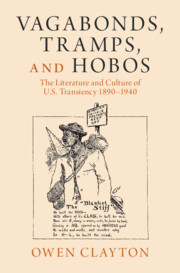Book contents
- Vagabonds, Tramps, and Hobos
- Cambridge Studies in American Literature and Culture
- Vagabonds, Tramps, and Hobos
- Copyright page
- Dedication
- Contents
- Figures
- Acknowledgements
- Part I Context
- Part II The Vagabond and the Tramp
- 2 In Search of Experience: Vagabond Travel Narratives
- 3 Vulnerable Youth and Hobosexuality in the Works of Jack London and A-No.1
- 4 ‘That’s Why the Lady Is a Tramp’: The Hidden Story of Female Transiency
- Part III The Hobo Transformed
- Conclusion: The End of the Road? Transiency beyond the Hobo
- Notes
- Bibliography
- Index
- Recent books in this series (continued from page ii)
2 - In Search of Experience: Vagabond Travel Narratives
from Part II - The Vagabond and the Tramp
Published online by Cambridge University Press: 27 July 2023
- Vagabonds, Tramps, and Hobos
- Cambridge Studies in American Literature and Culture
- Vagabonds, Tramps, and Hobos
- Copyright page
- Dedication
- Contents
- Figures
- Acknowledgements
- Part I Context
- Part II The Vagabond and the Tramp
- 2 In Search of Experience: Vagabond Travel Narratives
- 3 Vulnerable Youth and Hobosexuality in the Works of Jack London and A-No.1
- 4 ‘That’s Why the Lady Is a Tramp’: The Hidden Story of Female Transiency
- Part III The Hobo Transformed
- Conclusion: The End of the Road? Transiency beyond the Hobo
- Notes
- Bibliography
- Index
- Recent books in this series (continued from page ii)
Summary
Focussing on writing by Ralph Keeler, Lee Meriweather, Harry Franck, Stephen Graham and Vachel Lindsay, Chapter Two charts the development of a subgenre of writing that combines the slumming narrative with the travelogue, which I call the ‘vagabond travel narrative’. In this subset of travel literature, a narrator attempts to sightsee without money. These narratives make a spectacle of the supposed ingenuity of the narrator in acquiring, in the absence of financial capital, what I call ‘experiential capital’. Yet these texts also reveal, against the intentions of their authors, that it is their privilege as white men that enables these journeys and experiences. Vagabond writers set themselves apart from hobos and tourists, seeing both groups as too closely associated with modernity. Unlike the hobo, the vagabond travels to escape modernity – to go ‘off road’, rather than ‘on the road’, we might say. Yet Vachel Lindsay in particular shows an uneasy solidarity with the transient workers whom he inevitably encounters.
Keywords
- Type
- Chapter
- Information
- Vagabonds, Tramps, and HobosThe Literature and Culture of U.S. Transiency 1890–1940, pp. 47 - 78Publisher: Cambridge University PressPrint publication year: 2023



